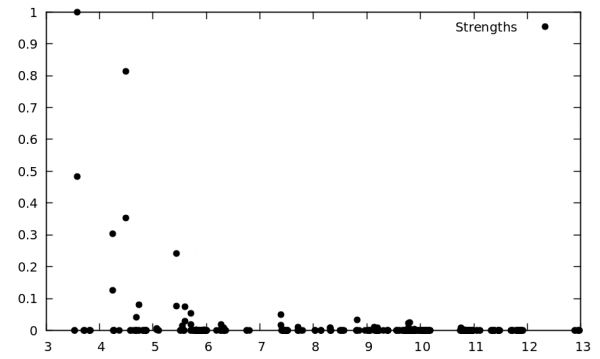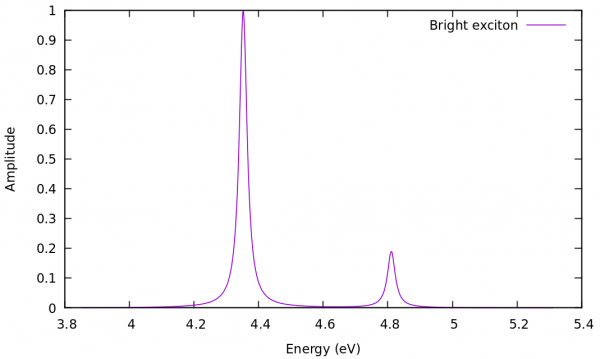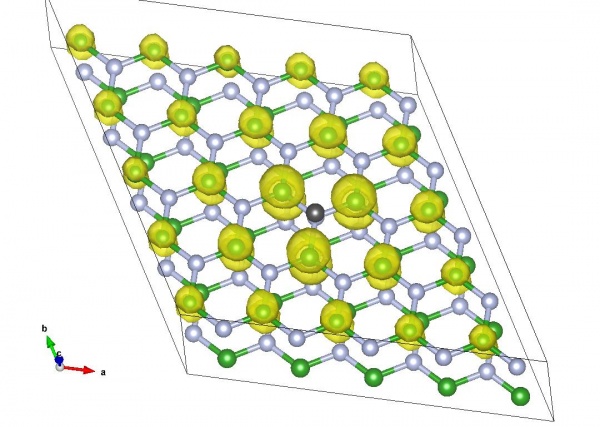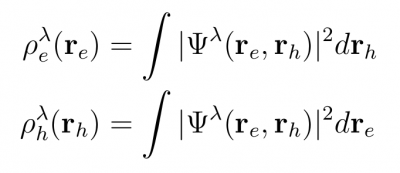Difference between revisions of "How to analyse excitons - ICTP 2022 school"
| Line 1: | Line 1: | ||
In this tutorial you will learn | In this tutorial you will learn how to: | ||
* analyze a BSE optical spectrum in terms of excitonic eigenvectors and eigenvalues | * analyze a BSE optical spectrum in terms of excitonic eigenvectors and eigenvalues | ||
* look at the spatial distribution of the exciton | * look at the spatial distribution of the exciton | ||
This is demonstrated for 3D-hBN. For a similar tutorial focusing on 2D-hBN and including finite-momentum BSE, go to [[How to analyse excitons|this page]]. | |||
== Prerequisites == | == Prerequisites == | ||
Revision as of 17:17, 28 March 2021
In this tutorial you will learn how to:
- analyze a BSE optical spectrum in terms of excitonic eigenvectors and eigenvalues
- look at the spatial distribution of the exciton
This is demonstrated for 3D-hBN. For a similar tutorial focusing on 2D-hBN and including finite-momentum BSE, go to this page.
Prerequisites
Previous modules
- You must have completed the Calculating optical spectra including excitonic effects: a step-by-step guide tutorial
You will need:
- The
SAVEdatabases for 3D hBN - The
ndb.BS_diago*databases for 3D hBN yppexecutablexcrysdenorVESTAexecutablesgnuplotexecutable
YAMBO calculations
If you have completed the tutorials on 3D hBN you should have all the databases required to do this tutorial in your YAMBO_TUTORIALS/hBN/SAVE and YAMBO_TUTORIALS/hBN/3D_BSE directories.
$ ls ./SAVE ndb.gops ndb.kindx ns.db1 ns.kb_pp_pwscf_fragment_1 ....
$ ls ./3D_BSE ndb.BS_Q1_CPU_0 ndb.BS_diago_Q1 ndb.dip_iR_and_P_fragment_1 ndb.em1s_fragment_1 ...
Sort the excitonic eigenvalues
We are now going to use ypp to post-process our BSE results.
First, type
$ ypp -J 3D_BSE -e s 1
which means that we are sorting the excitons for the q-index = 1 (optical limit q=0). The new generated file o-3D_BSE.exc_qpt1_E_sorted (along with o-3D_BSE.exc_qpt1_I_sorted ) reports the energies of the excitons and their Dipole Oscillator Strengths sorted by Energy (Intensity).
Open the first file and look inside. The first exciton is doubly degenerate at the energy of 3.54 eV, and the second one - also doubly degenerate - has the highest strength (normalized to 1). The latter exciton is the one appearing as the major peak in the optical absorption plots of the previous tutorials.
You can also make a plot:
$ gnuplot gnuplot> set style line 2 lc rgb 'black' pt 7 # circle gnuplot> plot 'o-3D_BSE.exc_qpt1_E_sorted' with points ls 2 title 'Strengths'
Attention: the convergence of these results with different k-points grids is mandatory!
Calculate the exciton oscillator strenght and amplitude
We can now analyze the excitons in terms of single-particle states: which electronic transitions are the most relevant? In order to do that, create the appropriate input with
$ ypp -F ypp_AMPL.in -J 3D_BSE -e a 1
Suppose you wish to analyze the first 4 excitons (i.e., the first 2 doubly-degenerate excitons). Then, change this line as:
States= "1 - 4" # Index of the BS state(s)
Close the input and run ypp
$ ypp -F ypp_AMPL.in -J 3D_BSE
$ ls o*exc*at* o-3D_BSE.exc_qpt1_amplitude_at_1 o-3D_BSE.exc_qpt1_weights_at_1 ...
For an exciton [math]\displaystyle{ |\lambda\gt }[/math] , o-3D_BSE.exc_qpt1_weights_at_* report the Weights
and o-3D_BSE.exc_qpt1_amplitude_** report the amplitudes
Open the file o-3D_BSE.exc_weights_at_3
# Band_V Band_C Kv-q ibz Symm_kv Kc ibz Symm_kc Weight Energy # 7.00000000 10.0000000 14.0000000 2.00000000 14.0000000 2.00000000 0.395135850 4.35248947 7.00000000 10.0000000 14.0000000 1.00000000 14.0000000 1.00000000 0.394993663 4.35248947 8.00000000 9.00000000 14.0000000 2.00000000 14.0000000 2.00000000 0.391943455 4.35241365 8.00000000 9.00000000 14.0000000 1.00000000 14.0000000 1.00000000 0.391800284 4.35241365 7.00000000 10.0000000 13.0000000 2.00000000 13.0000000 2.00000000 0.745555162E-1 4.81094742 7.00000000 10.0000000 13.0000000 1.00000000 13.0000000 1.00000000 0.745274872E-1 4.81094742 8.00000000 9.00000000 13.0000000 2.00000000 13.0000000 2.00000000 0.739243180E-1 4.81087065 8.00000000 9.00000000 13.0000000 1.00000000 13.0000000 1.00000000 0.738964081E-1 4.81087065
The third exciton is mostly composed of single-particle transitions from VBM to CBM at point H (last k-point of the grid, number 14) of the 3D hexagonal Brillouin zone, with contributions also coming from point K (number 13). All the contributions weighing less than 5% are not shown by default. Recall from the previous analysis that exciton states 3 and 4 (degenerate) are the optically active ones.
We can now plot the amplitude of the bright exciton:
$ paste o-3D_BSE.exc_qpt1_amplitude_at_3 o-3D_BSE.exc_qpt1_amplitude_at_4 > o-3D_BSE.exc_qpt1_amplitude_at_3_4 $ gnuplot gnuplot> set xlabel 'Energy (eV)' gnuplot> set ylabel 'Amplitude' gnuplot> p 'o-3D_BSE.exc_qpt1_amplitude_at_3_4' u 1:($2+$4)/2 w l t 'Bright exciton'
Recall that while this plot is related to the peaks in the optical absorption spectrum, it lacks the coupling with the external field, which is encoded in the dipole matrix elements.
Plot the exciton spatial distribution
To see the spatial character of the exciton, YPP writes the exciton spatial distribution, e.g., the probability to find the electron when the hole is fixed in a given position. Different output formats can be selected and to obtain 1D, 2D, and 3D plots.
Create the input and change the various parameters as shown below.
$ ypp -F ypp_WF.in -J 3D_BSE -e w
excitons # [R] Excitons wavefunction # [R] Wavefunction Format= "x" # Output format [(c)ube/(g)nuplot/(x)crysden] Direction= "123" # [rlu] [1/2/3] for 1d or [12/13/23] for 2d [123] for 3D FFTGvecs= 30 Ry # [FFT] Plane-waves States= "3 - 3" # Index of the BS state(s) Degen_Step= 0.0100 eV # Maximum energy separation of two degenerate states % Cells 5 | 5 | 1 | # Number of cell repetitions in each direction (odd or 1) % % Hole 2.35800028 | 1.36139178 | 7.08835602 # [cc] Hole position in unit cell (positive) %
One of the parameters, Cells, is the size of the cell where the exciton will be visualised.
Note that if the k-grid of the BSE simulation is a XxYxZ, then the exciton has an induced fictitious periodicity every XxYxZ cells of the simulation.
For hBN this is not a problem because the exciton is strongly localized, but in other systems, where excitons are more delocalized, it may b necessary to use
very large k-grids for the BSE calculation.
Also notice that, because of the value of Degen_Step, the code will automatically recognize and merge the degenerate excitons 3 and 4: you will see this in the log file.
Finally: how did we know at which coordinate to place the hole? It's best placed in the position where the valence electrons contributing to the exciton are localised. In the case of hBN, they are on the nitrogen atoms. We can obtain the Cartesian coordinates of these atoms from our previously generated o-3D_BSE.exc_qpt1_E_sorted file:
# Atom 1 with Z 5 [cc]: 2.35800028 1.36139178 0.00000000 # Atom 2 with Z 5 [cc]: -2.35800028 -1.36139178 6.08835602 # Atom 1 with Z 7 [cc]: -2.35800028 -1.36139178 0.00000000 # Atom 2 with Z 7 [cc]: 2.35800028 1.36139178 6.08835602
We take the positive values of the nitrogen(Z=7, last line) and shift the vertical position of the hole from 6.088 to 7.088 so that the hole does not end up in the center of the atom (and therefore, possibly in a node of the wave function).
Now close the input and run ypp
$ ypp -F ypp_WF.in -J 3D_BSE
After it's finished, we can visualise with xcrysden or with VESTA:
$ xcrysden --xsf o-3D_BSE.exc_qpt1_3d_3.xsf
$ VESTA o-3D_BSE.exc_qpt1_3d_3.xsf
We notice that the electron is completely confined on the boron atoms and on the same layer of the hole. For comparison, see for example ref. [1].
Plot electron/hole average density (only in Yambo 5.x)
Another way to analyze excitons, it is the possibility to plot the average electron/hole densities defined as:
to generate the corresponding input just type
ypp -F ypp_WF.in -e w -avehole
and choose the exciton you want to plot. The electron/hole average densities correspond to generalized valence/conduction orbitals for a given exciton. They are interesting in particular for molecular crystals because they allow distinguishing charge-transfer versus Frenkel excitons, from the relative position of the electron/hole densities.
If you want see an example of hole/electron density of excitons please have a look to ref. [2].
Summary
From this tutorial you've learned:
- How sort excitonic states by energy and intensity
- Analyse their composition in reciprocal space and in terms of single-particle transitions
- Visualize the exciton wave function in real space
Links
- Calculating optical spectra including excitonic effects: a step-by-step guide tutorial
- Back to CECAM 2021 tutorial page for the BSE
- Back to tutorials menu
- Back to technical modules menu
- ↑ Huge Excitonic Effects in Layered Hexagonal Boron Nitride, B. Arnaud et al., preprint ArXiv
- ↑ Strongly Bound Excitons in Metal-Organic Framework MOF-5: A Many-Body Perturbation Theory Study, A. R. Kshirsagar et al., preprint ChemRxiv






